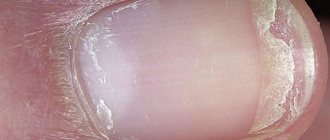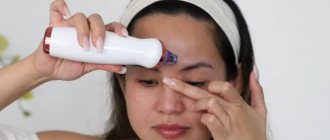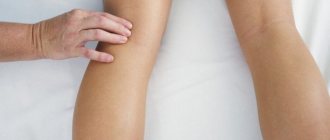The skin is not just a shell of the body, it is an independent organ, and the largest one if you compare the surface area and its weight. The body needs skin primarily to protect against bacteria, as well as to regulate temperature and transmit information about pain, heat or cold. The skin reacts both to external factors (sun rays, chemicals) and to the general condition of the internal organs. If something is wrong inside, then it is she who is the first to give signals, sometimes manifesting itself in the form of spots. The appearance of purple spots on the skin can be caused by both a violation of the integrity of the capillaries and the development of serious diseases. If such spots appear for no reason, you should consult a doctor.
Flaming nevus
If a blue spot appears under the skin, then this may be a manifestation of a flaming nevus. In fact, this is one of the types of dysplasia, which results in a violation of the integrity of blood vessels, those that are localized very close to the surface of the skin.
Outwardly, such a spot is very similar to a hemangioma, but there are still some differences. Firstly, the disease can be cured very easily, and secondly, there is no threat from an oncological point of view.
The form of education is incorrect. The blue spot on the skin cannot go away on its own, so people have to live with it throughout their lives. In children, the spot is pink, but over the years it will become a little thicker and take on a purple-blue color.
Not long ago, a scalpel was used to remove spots, but such treatment could cause the nevus to become malignant. Today, less traumatic methods of therapy are used to remove it, for example, laser exposure or cryotherapy.
Kaposi's sarcoma
Another disease that may cause a dark blue spot to appear on the skin is Kaposi's sarcoma. The disease mainly affects those people who live in Russia or Belarus. Such spots are only a symptom of incipient pathogenesis. Moreover, the tumor core itself will grow in the stomach or some part of the intestine.
A small blue spot on the skin may be similar to the development of lichen planus; it does not exceed fifty millimeters in diameter. The patient may feel pain upon palpation. There is a special group of people who are most susceptible to developing this disease:
- Residents of African countries.
- Patients with HIV or AIDS.
- Men suffer from the disease much more often.
If a blue spot appears on the skin, you must contact a medical facility. Treatment involves the use of local and systemic agents, interferons are taken, and in some cases radiation therapy is required.
Blue spot on skin photo
Thrombocytosis
Blue spots on the neck or blue spots on the head may be a sign of developing thrombocytosis. The disease is associated with blood platelets, or more precisely with the fact that their number increases. The main symptom of the disease is the appearance of blue spots. Many patients do not even notice such signs, but they may be accompanied by other symptoms that are difficult to pay attention to:
- Feeling of intense itching.
- Vision will deteriorate.
- There is a feeling of pain in the tips of the fingers.
The spots themselves do not cause any discomfort with this disease. Even if you press on the affected area, there will be no pain. That is why many patients do not even suspect the development of the disease, and at this time it continues to progress further. Moreover, the longer the disease is not diagnosed, the more serious the consequences can be.
Angiokeratomas on the body
Blue spots on the skin, but not a bruise, may indicate the development of angiokeratomas. Such skin rashes are a kind of dermatosis; the disease is benign.
Several groups of this disease can be noted:
- Farby's disease.
- Angiokeratoma of Mibbeli.
- Angiokeratoma of Fordyce.
The disease got its name from the name of the doctor who first described this pathology. In most cases, this disease is diagnosed in girls at the moment when they reach puberty.
In appearance, such rashes can be blue, purple, and are localized on the fingers and nails, as well as under the nails. The spots do not exceed five millimeters in size.
Fabry disease is a fairly rare genetic disorder. There are no more than five patients with this diagnosis per country. Moreover, this is not only a rare disease, but also very dangerous. In severe cases, a kidney transplant may be required.
How to deal with dark spots and redness on the skin of your hands
If dryness and loss of vitamins are felt on the skin of your hands only by you, then dark pigment spots and redness are visible to everyone. In addition, a crust may appear on the skin of the hands. Of course, I want to fix everything as soon as possible so that inflammation does not develop on my fingers. And there are several secrets here:
- Whitening hand mask. Mix a small amount of mashed potatoes with sour milk or milk. The mask should be kept for 15-20 minutes, then rinsed with water and applied nourishing cream to your hands.
- Softening and whitening paste. To prepare it, you need to add a little wheat flour and lemon juice or a weak vinegar solution to freshly boiled potatoes. This paste must be applied for 10-15 minutes.
- Remedy for severe redness on hands. Contrasting baths help best with red hands. First you need to make a hot bath with the addition of one teaspoon of mustard powder. Then you need to put your hands in cold water. You need to make at least three such transitions from a hot to a cold bath. After the procedure, dry your hands and apply vitamin cream to them.
- For peeling hands, a mixture of lemon juice and egg yolk helps a lot. The mask will be more effective if you add flaxseed oil and honey to it. Oatmeal will be an excellent helper for dry and flaky skin. Just boil it in water and add a little vegetable oil. This mask can also be applied to the face.
- The most effective remedy for removing dark spots and dirt is lemon juice with the addition of table salt. Rub your skin thoroughly with this mixture, then rinse your hands with water. If there are wounds or cracks on the skin, then using this recipe is not recommended.
- You can make the cream at home. To do this, dissolve a little gelatin in water, add glycerin and honey. The cream should be rubbed into damp skin of your hands every day before going to bed.
Along with external methods, you should not forget about taking vitamins internally. So, you can eliminate spots and prevent skin aging through two channels at once - outside and inside. It is better to use multivitamin complexes, ascorbic and nicotinic acid for these purposes. It is necessary to apply any of the described methods every day until the problem that bothers you is immediately eliminated. Then it is enough to repeat the procedures once a week for preventive purposes. If none of the methods helps, then it is best to consult a dermatologist. He will prescribe the necessary course of medication or cosmetic treatment, peelings or cryotherapy.
Treatment
It should be noted that treatment will only be effective if it is aimed at eliminating the underlying disease. In order for the skin to become a healthy color, it is necessary to normalize blood circulation.
Treatment should be carried out exclusively by a doctor; his specialty is determined based on the diagnosis. It is also useful to pay attention to your diet; you should only eat food that is rich in beneficial vitamins and substances. Drinking alcohol is not recommended, the same goes for smoking.
In some cases, you can use traditional medicine, but only after consulting your doctor. There are also traditional methods that allow you to get rid of blue spots - this is laser exposure. The duration of the procedure is no more than ten minutes, no pain is felt during it.
Remember that any disease is easier to cure if it is detected at an early stage of development. That is why, as soon as you notice suspicious symptoms, you need to visit a qualified specialist.
All medications prescribed by your doctor must be taken on time. It is useful to take relaxing baths and perform physical therapy. Once again, it is worth noting that you should never abuse bad habits.
Human skin is not just a tissue that covers the entire outside of the body. This is a huge organ that protects us from external influences: microorganisms, pressure, temperatures, chemicals. In addition, the skin is closely connected with our internal environment, and when any problems appear there, it makes them known by a general or local change in structure, elasticity and color. Thus, red spots on the legs, as well as a rash of a different nature in this location, are a signal that problems are happening to the body. In order to avoid hazardous health consequences, they must be identified and eliminated. Let's look at what the rash looks like for the most common diseases.
Types of stains
By a spot, people mean a local change in the color and structure of the skin in a certain location. Doctors use the word “spot” to refer to a small area of discoloration that does not rise above the level of the rest of the skin. Elements that protrude above the surrounding skin, are flaky, have a different density from other tissues, and have a cavity inside filled with light water or pus, have completely different names. This helps doctors narrow down the “circle of suspected” diseases.
In order not to confuse the reader, in this publication we will refer to all elements of the rash as a “spot”. Let's take as a basis the classification according to which spots are vascular or pigmented.
Vascular spots
These are formations of red, purple, brown, bluish or yellow color. Their color depends on the state of the blood in a given location: in which vessel it is located, whether it has exited it into the tissue or continues to be included in the bloodstream.
- those associated with temporary dilation of the vessel;
- associated with constant expansion of the vessel: spider veins, hemangiomas;
- hemorrhagic spots - resulting from the release of blood from a capillary
Dark spots
These are spots that develop as a result of increased or decreased melanin content. If there is a lot of pigment, moles, chloasma, freckles, and lentigo appear. When there is not enough of it, whitish areas appear on the skin: vitiligo, leucoderma.
There is one more type of stain that occurs as a result of the artificial introduction of dye into the skin, but this is not a worrying problem, and we will not consider it.
Red spots on the legs of adults
Rashes in the form of spots occur with the following diseases:
A brown spot on the skin with:
- Becker's nevus
- erythrasma
- persistent drug exanthema
- freckles
- borderline nevus, because may develop into melanoma)
- lentigo
- lentigo maligna
- melasma
- photoallergic rash
- stasis dermatitis
- black palmar lichen
A blue spot on the skin with:
- ink
- sky blue spots
- Mongolian spot
A red spot on the skin with:
- drug rash
- juvenile rheumatoid arthritis
- rheumatoid fever
- secondary syphilis
- viral exanthema
Hypopigmented spot on the skin with:
- anemic nevus
- post-inflammatory psoriasis
- pityriasis versicolor
- tuberous sclerosis
- vitiligo
- radiation dermatitis
To make a diagnosis and prescribe treatment, you need to consult a doctor:
- dermatologist
- allergist
- surgeon
- infectious disease specialist
- neurologist
- oncologist
Why do purple spots appear on the skin and how to deal with them?
Most common reasons
Purple or blue spots that form on the surface of human skin can be symptoms of many diseases. Of course, these can be ordinary bruises that form after a bruise, but they can also tell about internal pathologies that are not always noticeable to a person, or become symptoms of genetic diseases.
Considering that the purple spots themselves on human skin may differ from each other, we can say that the color, shape, and also the location of such a spot can suggest a disease from which the person is suffering.
Among the possible causes of purple spots on the human body are the following diseases:
- liver diseases;
- avitaminosis;
- rheumatoid arthritis;
- thrombocytosis;
- leukemia;
- marbled skin syndrome;
- Cobb syndrome;
- Fabry disease;
- flaming nevus;
- Kaposi's sarcoma.
This list is by no means complete. There are still many diseases in which one of the obvious clinical manifestations is violet, cyanotic or port-wine stains.
Of course, if any suspicious spot occurs, no matter where it appears - on the hands, on the face or on the back, it is better to consult a specialist and rule out possible serious diseases.
How to remove purple spots on hands?
If dark formations appear on your hands and do not go away for a long time, you should under no circumstances self-medicate or diagnose yourself using online forums. First of all, you need to seek medical advice from specialists: a dermatologist, allergist, hematologist, oncologist.
The doctor will be able to prescribe appropriate treatment only after establishing the correct diagnosis. To do this, it will be necessary to identify the true cause of purple spots on the hands.
Skin is a protective layer in the human body. It has a large area and weight. With its help you can protect yourself from bacteria and regulate your temperature. The skin will quickly inform the brain about the source of pain. It reacts instantly to heat or cold. Skin tends to change color when exposed to various chemicals and sunlight. If pathologies are observed in the human body, then it will first of all inform the brain about this. A blue spot on the skin indicates a violation of the integrity of the capillaries. Often this external manifestation indicates the presence of pathologies in the functioning of internal organs. In medical practice, cases have also been recorded where such pigmentation was causeless. However, only a doctor with sufficient qualifications in this field can say this.
Skin spots
Skin spots
may differ from each other in color, shape, location and origin.
The most common are red spots on the skin, less common are spots that are less intensely colored compared to other parts of the body, brown and so-called “blue” spots.
Red and white spots
Often, red spots are the result of infectious inflammation or allergies. They can be single, multiple, small or extensive, with a tendency to merge.
Most often, red ones are accompanied by the following diseases:
- food and drug allergies;
- some dermatological diseases, such as contact dermatitis;
- rheumatic fever;
- juvenile rheumatoid arthritis;
- vegetative-vascular dystonia;
- viral infections.
Less colored areas of the skin in the form of spots can be the result of fungal and infectious diseases, and may also arise due to the action of various unknown factors.
Conditions accompanied by the appearance of white or hypopigmented spots on the skin:
- pityriasis versicolor;
- radiation dermatitis;
- tuberous sclerosis;
- vitiligo;
- leucoderma.
Brown and blue spots
Brown spots are formed as a result of excess production of melanin by pigment cells in the skin. These spots can be congenital or acquired. Blue spots can also be congenital or acquired.
Brown spots most often occur with:
- Becker's nevus, borderline nevus;
- medicinal exanthema;
- lentigo;
- pregnancy;
- photoallergic rash;
- congestive dermatitis;
- erythrasma.
What to do
If the appearance of a spot is not caused by pregnancy, the application of dye under the skin for a tattoo, or “bruises,” then to identify the cause of its occurrence, you should contact a dermatologist, who, if necessary, will conduct an additional examination and also prescribe treatment. You should also definitely consult a dermatologist. if the spot changes color, becomes accompanied by pain, itching, or increases in size.
When spots appear as a result of an allergic reaction, antiallergic drugs are prescribed locally and internally, as well as drugs that reduce itching and sorbents. Some brown spots that do not pose a health hazard can be discolored using lemon juice, hydrogen peroxide, vinegar-protein masks, or hardware methods.
Useful information on the topic: Skin spots
How to keep your hand skin healthy and young
Pigmentation and any other dark spots on the hands look not just ugly, but not even aesthetically pleasing. Unfortunately, it is not so easy to fight them, but it is quite possible to prevent premature skin aging and the appearance of wrinkles, dryness and various types of formations. Just simple hand skin care is enough.
Constant use of household chemicals is clearly not good for the skin of your hands. The situation is especially aggravated if there is no washing machine at home and washing has to be done manually using such a synthetic powder that is harmful to the skin. After some time, you will notice that the already very thin skin of your hands has become even more transparent. Dryness, flaking and even eczema may appear. Of course, the best option is to use rubber gloves for any housework. Better yet, purchase SpaBelle moisturizing gel gloves, which not only perform a protective function, but also care for the skin.
If you still cannot get used to using gloves, then after any work you should wash your hands well with toilet soap (preferably children's soap), and then apply a rich cream to your skin. A cream with vitamins is ideal, since sensitive skin loses many beneficial elements when it comes into contact with water. This is the same basic care that does not require a lot of money and time.
In more advanced cases, your hands will require radical measures. First of all, you need to make hand baths. To do this, just brew chamomile, mint or linden. Baths can also be made from olive, castor or vegetable oils with the addition of ammonia. This product perfectly softens the skin and saturates it with beneficial microelements.
Blue spots on the body
Blue spots on the body for no reason can appear suddenly. In the case of such a symptom, it is necessary to urgently consult a doctor, because their appearance most likely indicates the presence of a serious illness. Moreover, many diseases, the symptoms of which are blue spots on the body, are very unpleasant. The formation of bruises on the skin for no reason may indicate the presence of diseases such as varicose veins, vasculitis, poor circulation, vascular fragility, lack of platelets or decreased blood clotting. Blue spots can also appear on the skin as a result of hormonal imbalances or long-term use of medications. Medicines such as analgesics, antidepressants, anti-asthma and anti-inflammatory drugs can also lead to the described symptoms. This is due to their ability to reduce blood clotting, which subsequently causes bruising.
There is a hypothesis that blue spots on the skin for no reason can arise as a result of a lack of vitamins such as K, P and C in the body. Due to their lack, vascular fragility occurs, which can subsequently lead to the appearance of bruises for no apparent reason.
Whatever the reason for the appearance of blue spots on the body, we recommend that you consult a doctor without delay, since a correct diagnosis cannot be made at home. And the reasons for the formation of such bruises can be both trivial and very serious. The doctor will conduct all the necessary tests, based on which he will draw conclusions and prescribe further methods of correct and effective treatment.
Other spots
If unusual formations appear on the skin, a person should first seek advice from a dermatologist.
Only a specialist can determine the disease by appearance, size, color, shape and other indicators and prescribe appropriate treatment.
If the case requires confirmation of the diagnosis, you will need to take scrapings from the damaged area and consult an oncologist or venereologist.
Depending on the problem, different treatments may be prescribed:
- the primary disease and the resulting spots are its symptoms;
- allergen, if allergy appears with supportive therapy;
- lichen spots, which require an integrated approach with the use of oral and external remedies, the use of hygiene products and strengthening the immune system;
- pigmented areas lightened with special means, peelings, mesotherapy, cryo procedures, laser.
Causes of Port-Wine and Purple Stains on Skin You Need to Know About
The skin is not just a shell of the body, it is an independent organ, and the largest one if you compare the surface area and its weight. The body needs skin primarily to protect against bacteria, as well as to regulate temperature and transmit information about pain, heat or cold. The skin reacts both to external factors and to the general condition of the internal organs. If something is wrong inside, then it is she who is the first to give signals, sometimes manifesting itself in the form of spots. The appearance of purple spots on the skin can be caused by both a violation of the integrity of the capillaries and the development of serious diseases. If such spots appear for no reason, you should consult a doctor.
Types of spots on the skin
Spots on the skin can have a wide variety of colors - pink, blue, wine, purple. They differ from normal skin only in color and sometimes peel.
Any spots that already exist or have just appeared on the skin are divided into:
- congenital;
- pigmented;
- acquired;
- vascular.
Spots on the body can be either light or dark, for example, purple. The reason for their appearance is a violation of skin coloration. Light-colored spots are very often a sign of overexposure to the sun's rays, and lovers of non-sea holidays may encounter this problem.
Another reason for the appearance of light spots on the skin may be fungal or other skin diseases that disrupt the production of melanin, which is responsible for the color of the skin. With a congenital disorder of this process, albinism can occur, when all the skin, hair and iris are completely white.
Dark, or port-wine, spots on the skin of a congenital nature are called moles or nevi. They can appear on the skin even in young children, but most often appear over the years. It must be remembered that under no circumstances should you remove them yourself or injure them, since there is a threat of moles developing into malignant formations.
Red or coffee-colored freckles appear under the influence of sunlight, but with the onset of the cold season they gradually lighten and disappear until next spring. Most often, the number of freckles decreases with age.
Brown or coffee-colored spots may appear on the skin of pregnant women.
But in old age, so-called brown liver spots most often appear. They do not darken when exposed to sunlight and are much larger in size than freckles. Their locations can be the hands, face or body. Such spots, as a rule, act as a cosmetic defect and do not pose a threat to health.
Sources: zdravotvet.ru, www.medicalj.ru, psoriazinform.ru, www.derm-atolog.ru, womanroutine.ru, omaske.ru
The skin is one of the first to signal a malfunction in the body; purple spots on the skin are confirmation of this. Often people simply do not pay attention to the so-called bruises, mistaking them for the consequences of careless movement and injury resulting from this reason. But in some cases, such neglect is unacceptable, since purple spots on the body can become evidence of a serious illness.
Why do purple spots appear on my hands?
Purple spots on the hands may indicate the development of purpura, a disease that causes blood capillaries to burst and red blood cells to stain the skin.
Often dark blue spots on the hands appear in people over 60 years of age. This indicates the development of the so-called senile purpura, when the walls of the blood vessels become thinner, which leads to the formation of dark spots on the hands and other parts of the body.
Purpura can also be a consequence of allergic diseases or poisoning with toxic chemicals. The disease can also be caused by long-term use of certain blood thinning medications.
In addition to these reasons, the following factors can cause purpura:
- surgical intervention;
- old injuries;
- blood clotting disorder;
- various infections, including human immunodeficiency virus (HIV).
Most common reasons
Purple or blue spots that form on the surface of human skin can be symptoms of many diseases. Of course, these can be ordinary bruises that form after a bruise, but they can also tell about internal pathologies that are not always noticeable to a person, or become symptoms of genetic diseases.
Considering that the purple spots themselves on human skin may differ from each other, we can say that the color, shape, and also the location of such a spot can suggest a disease from which the person is suffering.
Among the possible causes of purple spots on the human body are the following diseases:
- liver diseases;
- avitaminosis;
- rheumatoid arthritis;
- thrombocytosis;
- leukemia;
- marbled skin syndrome;
- Cobb syndrome;
- Fabry disease;
- flaming nevus;
- Kaposi's sarcoma.
This list is by no means complete. There are still many diseases in which one of the obvious clinical manifestations is violet, cyanotic or port-wine stains.
Of course, if any suspicious spot occurs, no matter where it appears - on the hands, on the face or on the back, it is better to consult a specialist and rule out possible serious diseases.
Causes of blue spots
If a blue spot appears on your hand, then this is a good reason for concern. Of course, it cannot be ruled out that this is still a simple bruise, but this could also indicate the development of some kind of pathology or even genetic diseases.
The most likely reasons why a blue spot may appear on a finger are as follows:
- Diseases affecting the liver.
- Lack of vitamins in the body.
- Leukemia.
- Marbled skin is a syndrome that does not occur very often, but such signs may indicate its development.
- Cobb syndrome.
- Kaposi's sarcoma.
- Flaming nevus.
This is not a complete list of why blue spots appear on the hands. Of course, if such symptoms appear, you should visit a doctor as soon as possible.
Blue spots on hands photo
Flaming nevus
Wine in medical practice is called the complex term “telangiectatic nevus” or flaming nevus. At its core, this is a type of dysplasia, characterized by a violation of the integrity of the structure of blood vessels, which are located quite close to the surface of the skin. Due to the characteristic color of the marks that appear on the surface of the skin, this pathology is popularly called port-wine stain disease.
A flaming nevus is very similar in appearance to a hemangioma, but there are some differences. Firstly, the disease has a very good prognosis for cure, and secondly, it does not pose an oncological threat.
This pathology develops during the prenatal period. Flaming nevus is found in 2-3 babies out of 1,000.
The shape of the nevus is usually irregular. Often, nevus does not go away on its own, leaving a mark for life. It is often pink in color in babies, but over the years it can thicken and darken, turning purple.
In some cases, a flaming nevus can become a symptom of the following serious genetic diseases:
- Cobb syndrome;
- Rubinstein-Taybi syndrome;
- Sturge-Weber-Krabbe syndrome.
These diseases require special treatment and attention from medical specialists.
Even in the recent past, a nevus was removed using a scalpel, but such treatment often led to the fact that the cells remaining after an unsuccessful operation became malignant and provoked the development of cancer. Today, there are more humane, and most importantly, effective methods for removing such a purple spot from the surface of the skin. We are talking about cryotherapy and laser removal of nevus.
The skin disease, which manifests itself in the form of fairly extensive spots of purple or purplish-red color, was until recently considered a lifelong aesthetic problem and caused significant difficulties in the social adaptation of patients. Considering that a port-wine stain is a congenital pathology caused by features of intrauterine development, children with this disease often grew up withdrawn and mentally unbalanced, especially if the port-wine stain was large and located on the face. In addition, the spot grows with its owner.
The doctor at the Linline clinic, Irina Podmaistrovich, claims that today aesthetic medicine can offer treatment of the skin of the face and other parts of the body using laser, and the earlier the therapy is started, the faster the port-wine stain will disappear from the skin.
Why does a port-wine stain appear on the skin?
This disease is called capillary angiodysplasia, and its essence is not in the tumor process, as some patients mistakenly believe, but in the pathology of the development of blood vessels, the network of which grows excessively in many layers in the upper layer of the dermis and creates the effect of spots of irregular shape and varying degrees of brightness. The disease manifests itself in newborn infants and progresses with age.
It should be explained to the patient that a port-wine stain does not go away on its own and does not resolve on its own. Although it does not pose a threat to life and health, without proper treatment it can enlarge, darken and even swell, which is caused by the vascular nature of the disease. Treating facial skin with port-wine stains using topical exfoliants and whitening agents is pointless. And since the presence of a port-wine stain on the face or body greatly interferes with the child’s socialization in society, this problem requires the earliest and most competent cosmetological intervention.
The essence of the pathology due to which a port-wine stain develops is a deficiency of contacts of nerve endings with certain parts of the capillary network or even a congenital complete absence of such contacts. As a result, the regulation of the diameter of the blood vessel is disrupted; it cannot contract to the required volume due to the lack of the necessary signal from the nervous system. And since these blood vessels are located very close to the surface of the skin, their expanded network appears as a wine-colored stain.










